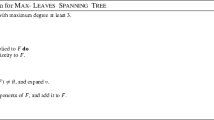Abstract
Given an undirected, connected graph, the aim of the minimum branch-node spanning tree problem is to find a spanning tree with the minimum number of nodes of degree larger than 2. The problem is motivated by network design problems where junctions are significantly more expensive than simple end- or through-nodes, and are thus to be avoided. Unfortunately, it is NP-hard to recognize instances that admit an objective value of zero, rendering the search for guaranteed approximation ratios futile.
We suggest to investigate a complementary formulation, called maximum path-node spanning tree, where the goal is to find a spanning tree that maximizes the number of nodes with degree at most two. While the optimal solutions (and the practical applications) of both formulations coincide, our formulation proves more suitable for approximation. In fact, it admits a trivial 1/2-approximation algorithm. Our main contribution is a local search algorithm that guarantees a ratio of 6/11, as well as showing that the problem is APX-hard, i.e., it does not allow a PTAS.





Similar content being viewed by others
Notes
The term forward node is motivated by the technical background of WDM networks, and, e.g., consistent with the definition of maximum forward-node spanning trees [17].
References
Bhatia, R., Khuller, S., Pless, R., Sussmann, Y.J.: The full degree spanning tree problem. In: Proceedings of the Tenth Annual ACM-SIAM Symposium on Discrete Algorithms (SODA’99), pp. 864–865 (1999)
Carrabs, F., Cerulli, R., Gaudioso, M., Gentili, M.: Lower and upper bounds for the spanning tree with minimum branch vertices. Comp. Opt. Appl. 56 (2), 405–438 (2013)
Cerrone, C., Cerulli, R., Raiconi, A.: Relations, models and a memetic approach for three degree-dependent spanning tree problems. Eur. J. Oper. Res. 232 (3), 442–453 (2014)
Cerulli, R., Gentili, M., Iossa, A.: Bounded-degree spanning tree problems: models and new algorithms. Comput. Optim. Appl. 42 (3), 353–370 (2009). doi:10.1007/s10589-007-9120-2
Fürer, M., Raghavachari, B.: Approximating the minimum degree spanning tree to within one from the optimal degree. In: Proceedings of the Third Annual ACM/SIGACT-SIAM Symposium on Discrete Algorithms (SODA’92), pp. 317–324 (1992)
Gargano, L., Hammar, M.: There are spanning spiders in dense graphs (and we know how to find them. In: Proceedings 30th International Colloquium on Automata, Languages and Programming (ICALP’03), Lecture Notes in Computer Science, vol. 2719, pp. 802–816 (2003)
Gargano, L., Hammar, M., Hell, P., Stacho, L., Vaccaro, U.: Spanning spiders and light-splitting switches. Discret. Math. 285 (1-3), 83–95 (2004). doi:10.1016/j.disc.2004.04.005
Gargano, L., Hell, P., Stacho, L., Vaccaro, U.: Spanning trees with bounded number of branch vertices. In: Proceedings 29th Intenational Colloquium on Automata, Languages and Programming (ICALP’02), Lecture Notes in Computer Science, vol. 2380, pp. 355–365 (2002)
Guha, S., Khuller, S.: Approximation algorithms for connected dominating sets. Algorithmica 20 (4), 374–387 (1998)
Khuller, S., Bhatia, R., Pless, R.: On local search and placement of meters in networks. In: Proceedings of the Eleventh Annual ACM-SIAM Symposium on Discrete Algorithms (SODA’00), pp. 319–328 (2000)
Knauer, M., Spoerhase, J.: Better approximation algorithms for the maximum internal spanning tree problem. In: Proceedings of the 11th Algorithms and Data Structures Symposium (WADS’09), Lecture Notes in Computer Science, vol. 5664, pp. 459–470 (2009)
Lu, H.I., Ravi, R.: The power of local optimization: approximation algorithms for maximum-leaf spanning tree. In: Proceedings of the Thirtieth Annual Allerton Conference on Communication, Control and computing, pp. 533–542 (1992)
Papadimitriou, C.H., Yannakakis, M.: The traveling salesman problem with distances one and two. Math. Oper. Res. 18 (1), 1–11 (1993)
Prieto, E., Sloper, C.: Reducing to independent set structure – the case of k-internal spanning tree. Nord. J. Comput. 12 (3), 308–318 (2005)
Rossi, A., Singh, A., Sundar, S.: Cutting-plane-based algorithms for two branch vertices related spanning tree problems. Optim. Eng., 1–33 (2013)
Salamon, G.: Approximating the maximum internal spanning tree problem. Theor. Comput. Sci. 410 (50), 5273–5284 (2009)
Salamon, G.: Degree-based Spanning tree Optimization. Ph.D. Thesis, Department of Computer Science and Information Theory. Budapest University of Technology and Economics, Hungary (2010)
Salamon, G., Wiener, G.: On finding spanning trees with few leaves. Inf. Process. Lett. 105, 164–169 (2008)
Silva, D.M., Silva, R.M.A., Mateus, G.R., Gonçalves, J.F., Resende, M.G.C., Festa, P.: An iterative refinement algorithm for the minimum branch vertices problem. In: Proceedinsgs 10th International Symposium on Experimental Algorithms (SEA’11), Lecture Notes in Computer Science, vol. 6630, pp. 421–433 (2011)
Solis-Oba, R.: 2-approximation algorithm for finding a spanning tree with maximum number of leaves. In: Proceedings of the 6th Annual European Symposium on Algorithms (ESA’98), Lecture Notes in Computer Science, vol. 1461, pp. 441–452 (1998)
Author information
Authors and Affiliations
Corresponding author
Additional information
This research started from an open problem posed at Dagstuhl Seminar 11191. The authors are grateful for Dagstuhl’s support.
Markus Chimani was funded by a Carl-Zeiss-Foundation juniorprofessorship
Rights and permissions
About this article
Cite this article
Chimani, M., Spoerhase, J. Approximating Spanning Trees with Few Branches. Theory Comput Syst 56, 181–196 (2015). https://doi.org/10.1007/s00224-014-9556-6
Received:
Accepted:
Published:
Issue Date:
DOI: https://doi.org/10.1007/s00224-014-9556-6




